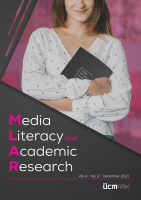Fake News Going Viral: The Mediating Effect of Negative Emotions
Fake News Going Viral: The Mediating Effect of Negative Emotions
Author(s): Nicoleta Corbu, Alina Bargaoanu, Flavia Durach, Georgiana UdreaSubject(s): Education, Psychology, Media studies, Communication studies, Sociology
Published by: Univerzita sv. Cyrila a Metoda v Trnave, Fakulta masmediálnej komunikácie
Keywords: Discrete emotions;Experimental design;Fake news; Viralisation effects;
Summary/Abstract: In recent years, “fake news” has become a buzzword used to describe a variety of disinformation practices identifiable both in the traditional media, and in the digital environment. The goal of our paper is to investigate fake news, aiming at both clarifying the concept and discussing the possible integration of ideologically driven information under this large umbrella, as well as investigating conditions under which various types of fake news have the potential to go viral. In this study we consider ideologically driven news as a form of disinformation, by the mere reason that there is a clear intention to deceive behind this type of news. At the same time, we argue that, compared to no more than one-two decades ago, ideologically driven information is potentially much more harmful, by virtue of the potential of being shared, easily further disseminated within echo-chambers and with the help of filter bubbles. In line with recent studies, we contend that, at its core, the fake news problem concerns the economics of emotion, specifically how emotions are used and often abused to foster audience’s attention, engagement, and willingness to share content. In this context, and under the recent political circumstances in Romania (marked by anti-government protests and public opposition to the ruling political party), our aim is to better understand how people’s susceptibility to disseminate deceitful information is enhanced by various forms and valences of politically biased fake news, and what is the role of specific emotions in explaining this process. Bulding on Tandoc et al.’sclassification of fake news, we propose a 2x2x2 experimental design, in which we manipulated intention to deceive, level of facticity and valence. The survey experiment (N=813) tests two positive (enthusiasm and contentment) and two negative (anger and fear) discrete emotions as mediators of the main effect of potential of viralisation effects (i.e. how likely users are to share fake news on a social network). Results show that negatively biased fake news enhances people’s willingness to share the news story, while positively biased fake news has no significant effect on the viralisation potential. Moreover, the potential for viralisation is mediated by negative emotions, but not by positive ones.
Journal: Media Literacy and Academic Research
- Issue Year: 4/2021
- Issue No: 2
- Page Range: 58-87
- Page Count: 30
- Language: English

